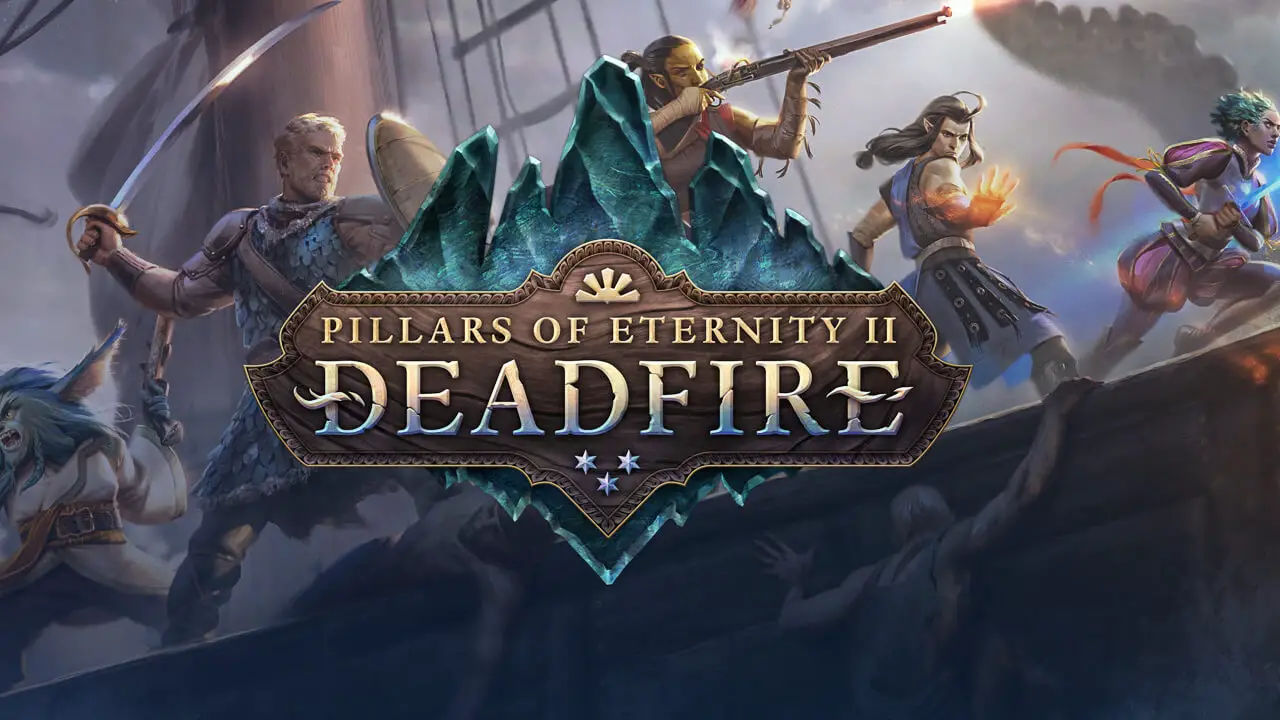You enter the dungeon. You see an intricate ancient relic. What do you do? Roll for perception check.

Personally, I never played table-top RPGs. Maybe that’s why “magic” of such games as Baldur’s Gate or Pillars of Eternity would never affect me on the same level as those who did spend hours in the company of their friends being lead through mysterious labyrinths by Dungeon Masters.
But I can still recognize a compelling story, well-crafted world, and nuanced characters when I see them. And in case of Pillars of Eternity II: Deadfire it’s… Well, it’s complicated.
Pillars of Caribbean Game of Thrones and Dragons
Game creators had put a lot of effort in their lore, I grant them that. Familiar fantasy races and conventions are mixed here with the political landscape of “Age of Pirates” (I mean history period, not the game). Around Deadfire archipelago you meet elves, dwarfs and a bunch of other races, roaming the seas in search of riches and adventures. Islands themselves fall into spheres of influence of half-a-dozen factions.
Trading Companies from Vailian Republics and the Kingdom of Rautai compete in exploring (and exploiting) Deadfire resources. Huana tribes, natives of the archipelago, are zealous in protecting their power and traditions, though not all of them entirely reject outsiders. There are two pirate factions – one more and one less noble.
And while “Children of Dawnstars” is a cult with only a minor presence on Deadfire, they are worshiping Eothas. A god, who recently manifested as a giant living statue and now gathering energy from the pillars of luminous adra – a substance that is charged by living (and dead) souls.
On his awakening Eothas destroyed your (Pillars of Eternity protagonist) citadel and killed most of its inhabitants, absorbing the energy of their souls. Even your soul was partially absorbed, so there is no choice for you but to pursue the colossus. That’s why your interaction with “Children of Dawnstars” will become rather important. And also one of them, priestess Xoti, can become one of your party members.

Speaking of your party. You can have no more than four companions. So choose carefully, especially considering that each of potential recruit has own strength and weaknesses in terms of skills. Without certain “perks” and requirements met some quests and solutions will be impossible due to numerous “skill checks”. Not to mention skills needed for stealth, thievery and trap disarmament.

Don’t forget that each companion has own priorities and affinities. Almost every decision of yours is favored by ones and displease others. Luckily there is a special tab that shows party members’ preferences in personality traits and dialog options that affect your disposition for those traits are marked (unless you turn markers off).
Many NPCs, including faction leaders, also react differently according to your dispositions. Obviously, they take into account your deeds for/against factions in general. But for companions it goes even further – they have reputations even among themselves. If their affinity to each other is good enough some can even start a romance. Unless, of course, they are in a romance with you.

As you can guess, with such a tangled system of relations it’s impossible to please everyone. And no matter how wise and accurate you maneuver “politically”, you will inevitably face some “what the hell should I do so I won’t piss people I rely on” situations. Which, with the addition of classic moral dilemmas, make Deadfire an outstanding game in terms of dealing with non-player characters.
Though characters themselves are, sadly, not so outstanding. Yes, there are quite a few well-rounded and fully fleshed individuals among “recurring cast”. But none of them are too memorable or unique to stand in NPC “hall of fame”.
A turn for combat
In case you were wondering, what does this review doing on “Turn-based lovers” site, there is indeed turn-based combat in Pillars of Eternity II: Deadfire. And despite a large focus on a story and conversations, you can’t avoid combat encounters. Some boss fights are a part of the main quest and mobs guard a lot of precious loot.
Like most things in PoE, combat is simple on the surface but has a lot of nuances. All characters move and act in their turn, but in addition to movement and one standard action (which is an attack, casting a spell or changing weapon in hands) there are also “free actions” that you can perform. Those include: changing of battle stance to trade, for example, attack stat for defense, buffing certain ability (can be performed once per battle), restoring HP (also once per battle).

Buffing or debuffing can be also done by spells or other class abilities. In terms of the game, it’s called “Inspirations” and “Afflictions”. They don’t last long, unlike “Injuries” caused by critical hits and triggered traps, that persist until you rest and eat some food. Btw, certain food and places of rest also give “rest bonuses” that generally are active until the next rest. And in addition, there are a few “until rest” bonuses that you get after receiving some… ahem… “entertainment” in certain establishments.
There are actually quite a few parameters that can be affected by mentioned bonuses/penalties. There are four types of defense alone. And those just determine the probability of how different attacks hit, critically hit, graze or completely miss you. Only then armor/penetration rating come in play on how much damage you actually receive. And armor rating can also be different for different damage type.
Of course, those parameters are “secondary” and are derived from six main attributes (Might, Constitution, Dexterity, Perception, Intellect, Resolve) and further affected by equipment and other bonuses. Sadly, not by skills though – don’t expect, for example, Insight to increase your crit chance.
However, some active skills do affect your abilities in battle. For example, Arcana increases the power of scroll spells or Explosives reduces the chance of being caught in your own explosion.
But don’t be quick to complain about lack of options. As combat abilities do exist on a separate “ability tree” and you acquire them during level-up just as non-combat skills and weapon proficiency. The most powerful and complicated abilities are available on the highest levels, but even initial spells (or chants, or prayers – different classes abilities are called differently and have slightly different “resource” consumption rules) increase their power with level up and are useful for a quick attacks (as a high-level spells take more than one turn to finish).

Did it sound overly complex? Probably, because it kinda is. Complexity is sort of double-edged sword for Pillars of Eternity. It allows you to dive into formulas and conduct numerous experiments in search of the optimal solutions (in combat and otherwise) fitting your unique personal play-style. But at the same time, it makes the first walkthrough very frustrating at times. You have dozens of “perks” to choose from for each character and not aware of some nuances until you try them.
Similar frustration awaits you on studying combat tactics. “Flanked” state apparently happens when you attack an enemy by two fighters from certain angles. And sometimes when you order one character to attack, others will move to make way for him. And sometimes they won’t.
For those who are too frustrated by turn-based quirks, there is, of course, real-time mode. Which initially was the only combat mode. It has its own problems and essentially it’s simply a matter of preference what you want to choose. At least, for now, players haven’t discovered any real advantages in one mode or the other.
Prepare for some epic… reading?
But for me personally, the weirdest thing was the amount of “narrative segments”. On one hand, I understand the reason – a tight budget. It makes sense that instead of making an expensive CGI video one can just draw a set of stylish illustrations to accompany the narrator’s voice describing the scene.

This not only saves money but also allows to insert some choices for the player akin dialog options. And the whole scene becomes interactive, increasing player engagement without many additional resources spent.
However, extensive use of such trick turns a game in a sort of “Visual Novel”. Not that I have something against VN genre, but I’m playing RPG, am I not? And I have enough reading in dialogs since in addition to what character says, many options describe what character does, how looks and even thinks. If you can’t make gorgeous CGI scene, why make a scene at all? Why not use the game’s own engine to depict it?

And the last thing I have a complaint about is the game’s optimization. Especially rather long loading times. Seriously. Some MMOs are loading faster than this! Not to mention old-school games like Baldur’s Gate.
Yeah-yeah, I know – high-definition textures, 3D-models, lots of FX shaders need their space in memory and time to load. But I would rather play PoE with BG graphics if the loading time was the same. It’s well-known that Unity is not the most performant engine, but there are still ways to make the code more efficient and fast.

Still, even with those major (and minor) problems Pillars of Eternity II: Deadfire is the best old-school RPG experience the modern industry has to offer. Well, maybe besides Divinity Original Sin.
A fresh take on a high-fantasy setting. Complex systems of interactions in combat, in politics and in your own party. Numerous non-linear quests. Even official tools for modders. If you are ready to spend enough time to learn the game’s nuances, it will open for you an entirely new world.








3 thoughts on “Pillars of Eternity II: Deadfire (with turn-based combat) – Review”